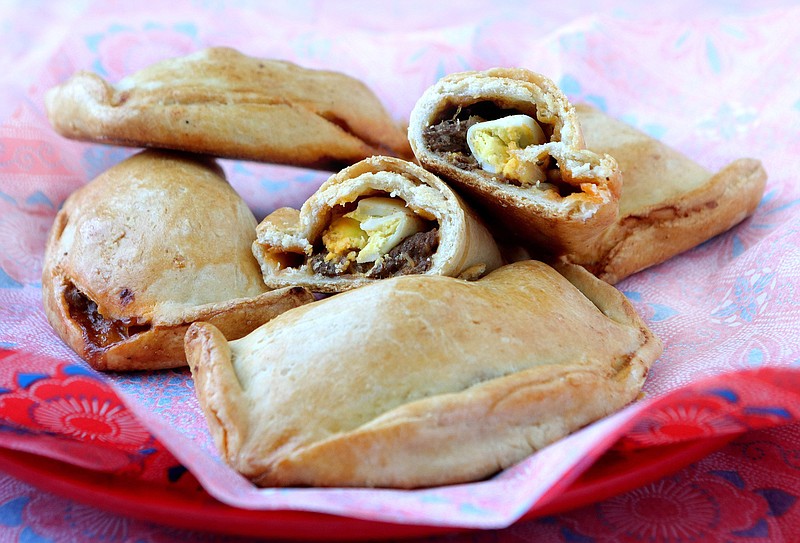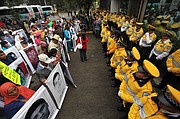Empanadas - those familiar, golden, hand-held pies - are popular throughout Central and South America, from Mexico to the southernmost tip of Argentina.
But in Chile, they are something of an obsession. You could call empanadas the national dish of Chile, and no one would argue with you.
In Chile, you can buy them at restaurants, bakeries, fast-food joints that specialize only in empanadas and bars. And, naturally, you can also pick some up from the occasional street vendor, especially near busy train stations.
Though they are an essential part of life in Latin America, empanadas are known to have come from Spain, where they rated a recipe in a Catalan cookbook back in 1520. But their origins are thought to date back long before that; one theory suggests they are a Spanish and Portuguese version of the Middle Eastern samosa.
The word "empanada" comes from the Spanish verb "empanar," meaning "to wrap something in bread." And that's what an empanada is, a filling entirely enveloped in pastry. The genius of an empanada is that the filling can consist of virtually anything.
It can be sweet or savory; meat-packed, fruit-filled or vegetarian. I've heard of empanadas filled with razor clams or lobster or bananas with Nutella. If it is edible and can fit inside an empanada, someone has probably made it.
But our interest today is in empanadas from Chile. Two types of Chilean empanadas are the most common by far: empanadas de pino, which are filled with a mixture of beef and onions, plus raisins, olives and wedges of hard-boiled egg; and empanadas de queso, which are filled with gooey, melted cheese.
The beef-filled empanadas de pino are typically baked and the cheesy empanadas de queso are usually fried, but either kind can be made both ways.
I'm a traditionalist, so I baked the beef and fried the cheese. Either way, and with either filling, they were superb.
The trick to making cheese empanadas is to use cheese that melts easily. I looked through several recipes to try to get a consensus, but all I found was chaos. One story talked about cheddar-filled empanadas, which sounds to me too much like a fried grilled cheese sandwich.
Now that I think about it, that's a wonderful idea.
Most of the other recipes called for mozzarella, while the remainder used muenster. Mozzarella is a bit bland, while too much muenster would be too much, so I hit upon a savory compromise. I used a combination of them, favoring the mozzarella over the muenster.
That's why they pay me the big bucks. It was a blissful mix that melded perfectly with the golden-fried and almost flaky dough.
The beef empanadas, I am happy to report, were every bit as good as the cheese. They do take a little more effort, but they are well worth it.
I first sauteed onions and then did a trick I picked up from Indian cooking: I added the spices directly on the onions. That intensely flavored the onions and the oil, which then imparted those flavors to the beef when I added it just a few seconds later.
A bit of gravy comes next - it's just a matter of adding beef broth, water and flour into the skillet - and then the olives, raisins (for a dash of contrasting sweetness) and hard-cooked egg that make the dish uniquely Chilean.
The beef empanadas were incredibly satisfying, all the more so because I made the filling the night before to allow the flavors to meld.
I baked the beef empanadas in the traditional rectangular shape and the fried cheese empanadas in the traditional half-moon shape, but honestly you could make them in any shape you wish and they would still taste just as good.
These empanadas are simply glorious. You can easily see why they are such a comforting part of Chilean culture. They are so irresistible, it is tempting to move to Chile just for the empanadas.
But why go to all that trouble when you can make them yourself?
Empanada Dough
Yield: 12 servings
2 pounds all-purpose flour, about 7 cups
1 tablespoon baking powder
1 teaspoon salt
7 ounces (1 scant cup) lard
2 cups water
In a large bowl, sift together flour, baking powder and salt. Stir to combine. Cut in lard with pastry blender or 2 knives until mixture resembles crumbs (alternatively, melt lard and stir it in). Add water, a little at a time, and stir together or use your impeccably clean hands to mix until dough just comes together; you may need to use less or more water. Knead briefly until smooth. Cover and refrigerate 20 minutes. Both the dough and the uncooked empanadas can be frozen.
Per serving: 426 calories; 17 g fat; 7 g saturated fat; 16 mg cholesterol; 8 g protein; 58 g carbohydrate; 1 g sugar; 2 g fiber; 198 mg sodium; 67 mg calcium
Recipe by Daniel Neman
Cheese Empanadas
Yield: 12 servings
24 ounces shredded cheese that easily melts, such as mozzarella or muenster, or a combination of cheeses
Empanada dough or refrigerated pie crust dough
Oil for frying
1. Cut empanada dough in half. Cover half with plastic wrap and return to refrigerator. Roll out dough to a thickness of about 1/8 inch. Use a bowl or similar implement to cut out 6 uniform circles of dough, ideally about 7 inches in diameter.
2. Place a few tablespoons of cheese on half of one circle, leaving a border of 1/2 inch. Brush water around the border. Fold half of circle over the filling and press to seal tightly. Crimp border or press with fork tines. Repeat process with remaining dough, including dough in refrigerator.
3. Pour oil into large pot over to a depth of a few inches. Heat over medium-high heat to 350 degrees. Carefully fry empanadas in small batches until golden brown, a few minutes. Drain on paper towels and serve warm.
Per serving: 674 calories; 37 g fat; 14 g saturated fat; 53 mg cholesterol; 21 g protein; 63 g carbohydrate; 1 g sugar; 1 g fiber; 584 mg sodium; 466 mg calcium
Recipe by Daniel Neman
Beef Empanadas
Yield: 12 servings
2 tablespoons oil
1 large onion, chopped
1/2 teaspoon cumin
1 tablespoon paprika
1 pound beef, such as top round, cut into 1/2-inch dice
1/2 teaspoon salt
Ground pepper
12 pitted olives
24 raisins
1/2 cup beef broth
1/2 cup water
1 tablespoon all-purpose flour
Empanada dough (see recipe), or refrigerated pie crust dough
3 hard-cooked eggs, cut into quarters
1 egg, optional
1 tablespoon milk, optional
Note: This recipe is best if filling can rest overnight.
1. Heat oil in a skillet over medium-high heat until shimmering. Add onion and saute until translucent, 3 to 5 minutes. Stir in cumin and paprika until all the onions are colored by the mixture. Add the beef and the salt. Season well with pepper. Cook until beef is done, a few minutes. Stir in olives and raisins.
2. Add broth and water, and bring to a boil. Stir in flour and cook, stirring occasionally, until sauce is thickened and no longer tastes like flour. Taste for salt and pepper. If possible, refrigerate overnight.
3. If baking the empanadas, preheat oven to 350 degrees.
4. Cut empanada dough in half. Cover half with plastic wrap and return to refrigerator. Roll out dough to a thickness of about 1/8 inch. Use a bowl or similar implement to cut out uniform circles of dough, ideally about 7 inches in diameter.
5. Place a couple of tablespoons of filling on half of one circle, including 1 olive, leaving a border of 1/2 inch. Add one wedge of hard-cooked egg. Brush water around the border. Fold half of circle over the filling and press to seal tightly. Fold over the pressed sides to form a rectangle. Repeat process with remaining dough, including dough in refrigerator.
6. If desired, whisk together egg and milk and brush on top to make a glaze (do this only if baking the empanadas, not frying them). Bake until golden brown, about 30 to 35 minutes; or fry in small batches for a few minutes in 350-degree oil until golden brown. If fried, drain on paper towels.
Per serving (using baked method): 577 calories; 24 g fat; 9 g saturated fat; 125 mg cholesterol; 28 g protein; 61 g carbohydrate; 2 g sugar; 2 g fiber; 408 mg sodium; 93 mg calcium
Recipe by Daniel Neman



